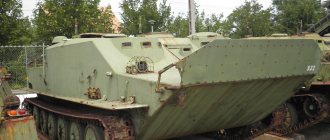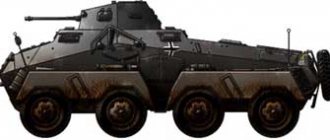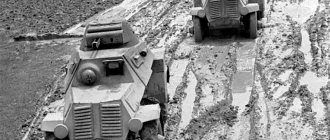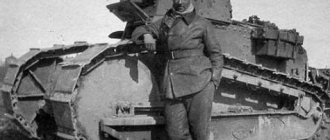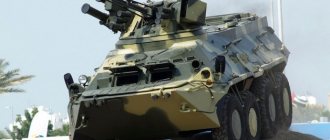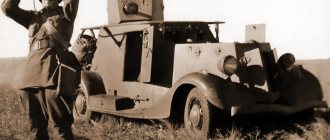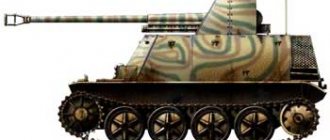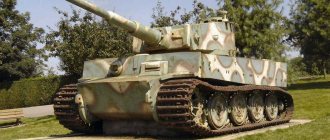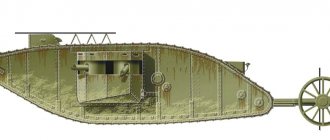The idea of a machine with the mobility of a chariot, the security of a fortress and the power of artillery arose in the Renaissance. Leonardo da Vinci and later other inventors hatched similar projects. But to no avail - such a vehicle required: light and durable armor, compact and powerful draft force and highly effective small-sized weapons. The necessary components appeared at the end of the 19th century.
Modern model of an “armored vehicle” based on the drawings of Leonardo da Vinci
Using armored trains, the British realized the need for maneuverable weapons that were not tied to the railway. internal combustion engine created by the Germans G. Daimler and K. Benz was just suitable for such a machine . They designed the first cars with such engines in 1895–1896.
During the Boer War, F. Simms offered the army the first armed vehicle . He installed a Maxim machine gun on the French single-seater De Dion-Bouton . The driver-gunner was protected by a shield of sheet steel, the production of which became possible with the advent of rolling mills. Although the car had four wheels, it resembled two motorcycles connected, and the driver sat astride it. Therefore, Simms' invention is sometimes called a military motorcycle .
Armed car of F. Simms. 1899
The single-seat layout did not allow conducting aimed fire and simultaneously controlling the vehicle. In 1902, Simms designed an armored bus with a machine gun and a crew of 5 people. But things never came to the point of putting Simms’ inventions into practice, and with the end of the Boer War, the military’s interest in the new product faded.
F. Simms armored bus
In the 1900s armored car projects are appearing in different countries . The first to be built was the Austrian "Austro-Daimler" in 1904 . with bulletproof armor and a machine gun in a rotating turret on the roof. At the same time, in Russia, M. Nakashidze armored car based on the French Charron truck . The Russian army, having appreciated armed vehicles in battles with the Japanese, ordered 10 Nakashidze-Sharron . Due to the busyness of Russian factories, the order was placed in France. When transporting finished vehicles through Germany, 2 armored cars disappeared. Perhaps it was on their basis that the Germans in 1906 created their armored car with a 50-mm anti-aircraft gun.
But neither the Austrian, nor the German, nor a number of other armored vehicles of those years went into production. Russia also limited itself to an experimental batch. The military was in no hurry to spend money on a dubious new product, and by 1914 the troops had only a few examples of armored cars. Only the success of the use of these vehicles at the beginning of the First World War gave rise to the mass construction of armored vehicles.
Armored car "Austro-Daimler". 1904
Armored car "Erhardt". 1906
Armored car "Nakashidze-Sharron". 1904
Armored cars of the First World War
Automatic weapons, grenades, mortars, flamethrowers and gases created to overcome the defense did not solve the problem of “positional impasse.” Defenders also used them, while, unlike attackers, remaining in cover. Only by making the “shelter” mobile and capable of attacking could the advantage of the defense be broken. The need to provide troops with such “mobile bunkers” pushed the development of armored vehicles.
Belgian armored car "Minerva". 1914
Since the beginning of the war, civilian vehicles have been armored and armed everywhere. The first hastily assembled samples, such as the Belgian Minerva , received lightweight and easy-to-manufacture armored hulls without a roof or doors. The crew boarded and disembarked through the side. Machine guns were mounted on rotating mounts ( turrets ), sometimes with shields.
Open armored hulls did not protect against shrapnel and fragments from above. Soon the Nakashidze scheme with continuous armor and a rotating machine-gun turret became the main one everywhere. The most popular such car was the English Rolls-Royce , created on the basis of a luxury car of the same name with a powerful engine for those times.
Rolls-Royce armored car. 1915
The Russian army fought on a front stretching from the Baltic to the Caspian Sea. More armored cars were needed than Russian factories produced. We had to buy any vehicles that the allies were selling. Renaults came to Russia . This car was redesigned by Staff Captain V. Mgebrov, creating on its basis one of the best armored cars of that war, “Mgebrov-Renault” . To enhance protection without increasing mass, for the first time he installed armor plates not vertically, but at an angle. It was more difficult to penetrate such a sheet, and often, when hitting the armor at an acute angle, bullets, fragments and shells ricocheted (bounced off). Mgebrov was also the first to install a commander’s turret above the machine-gun turret to monitor the battlefield.
The armor protected the vehicles from bullets at a distance of 200 m. From this distance, the machine guns of the armored cars could not reach the enemy in the trenches or penetrate dugouts and bunkers. Cannon weapons could hit such targets from a safe distance. Russia was the first with cannon armored cars Mannesmann-Mulag and American Packard trucks were converted into them .
Armored car "Mannesman-Mulag"
In order not to overload the car, only the cabin was fully armored. Heavy and powerful field guns were not suitable for installation on light vehicles of that time. But the small-caliber guns that served in the navy to combat fast boats were lighter and had less recoil. 47 mm Hotchkiss cannon or a 37 mm Maxim-Nordenfeld was mounted on a platform in a body armored only on the sides.
The vehicles with guns performed well, but the crew in the back was vulnerable. In 1915, the Putilov plant began producing fully armored cannon and machine gun vehicles based on the American Garfard . The armored car received three turrets - two machine guns in front and a rear one, with a 76-mm fortress anti-assault gun mod. 1910 _ Its high-explosive shells destroyed bunkers and dugouts, and its shrapnel hit infantrymen in the trenches. The heavy vehicle moved slowly; it was difficult for it to escape from enemy artillery fire. But thanks to reliable armor and guns, the need for withdrawal arose infrequently.
The Garfard armored car is a self-propelled fortress. 1915
Armored cars and armored personnel carriers of World War II
The task of light armored vehicles was reconnaissance, medium and heavy ones were also used for fire support of infantry. But armored personnel carriers, allowing the transport of soldiers under the protection of armor, became a new class of military equipment - their widespread use began only during the Second World War.
M3 armored personnel carrier. USA. 1941–1945
The Second World War promised to be a maneuver war, and the generals decided to equip their armies with gun-powered armored vehicles . While armed no worse than that of light tanks, the armor of such vehicles was thinner. We can say that their security was “traded” for speed. Cannon armored vehicles could be quickly transferred to another section of the front - however, only along relatively good roads, but this was also a lot.
BA-10 and heavy BA-11 were created in the USSR . Germany was armed with cannon versions of the Sd.Kfz.231 . In the USA, they realized the importance of vehicles of this class later - the M8 Greyhound appeared at the front only in 1942. True, the Americans took the matter seriously: the “Grey Hound”, as the name of this armored car is translated, weighed almost twice as much as the heavy BA- 11 and carried a 51 mm caliber gun.
Sd.Kfz.222. Germany
Having relied on “blitzkrieg” (lightning-fast maneuver warfare), Nazi Germany paid special attention to troop mobility. The motorized infantry was supposed to break through the enemy defense line after the tanks. The enemy fired at the flank of those breaking through, and the motorized infantry had to be protected - at least from bullets and shell fragments, mines, and grenades. the armored personnel carrier (APC) appeared . Vehicles of this class, as a rule, were half-tracked - a compromise between maneuverability and labor intensity of production.
was built according to this scheme . 251 is the most popular armored vehicle of the Third Reich. The main model of the armored personnel carrier was Sd.Kfz.251/1 . It carried 10 motorized infantry and carried 1–2 7.92 mm machine guns. The crew, consisting of the vehicle commander and driver, and “passengers” were protected from bullets and shrapnel by armor up to 14.5 mm thick. The top of the body was open, because the roof would prevent infantrymen from quickly leaving the armored personnel carrier when fired by artillery or heavy machine guns, from which thin armor did not protect. The military, although they scolded armored personnel carriers for their poor maneuverability, demanded that as many of these vehicles as possible be supplied to the army.
BA-10. USSR
the M2/M3/M5/M9 family were close in characteristics to the German ones . These vehicles turned out to be in demand for the safe transportation of troops not only by the US Army, but also by the allies, and under Lend-Lease (the allied supply program) they also ended up in the USSR. 41,000 of these armored vehicles were produced - an absolute record for armored vehicles of the Second World War.
Armored personnel carriers have been widely used as platforms for various types of weapons and special equipment. For example, the Sd.Kfz.251 was produced by the Germans in 23 modifications with various types of guns, as well as in headquarters, signal, sapper and even ambulance versions.
M8 Greyhound. USA
Known samples[ | ]
| The neutrality of this section has been questioned. There should be details on the talk page. |
- Finnish wheeled armored personnel carrier Rosomak.
- German half-track armored personnel carriers of the Second World War SdKfz 251 and SdKfz 250.
- Soviet BA-64 armored car based
- English tracked armored personnel carrier of the Second World War Universal Carrier.
- American LVT amphibious series: LVT(A)-2, LVT(A)-3.
- American half-track armored personnel carriers of World War II and .
- Soviet series of wheeled armored personnel carriers with the formula 8x8 BTR-60, BTR-70, BTR-80 and its successor BTR-90.
- Soviet multi-purpose lightly armored transporter MT-LB (with numerous modifications)
- German wheeled armored personnel carrier with the formula 6x6 TPz Fuchs (“Fuchs”).
- German-Dutch family of multi-purpose armored personnel carriers "Boxer"
- A series of French wheeled armored personnel carriers with the 4x4 VAB formula.
- Heavy tracked Israeli armored personnel carrier "Akhzarit".
- The EFV amphibious armored personnel carrier is the first in the world capable of gliding
- Armored personnel carrier BTR-40, a combat vehicle of Soviet motorized riflemen in the 1950s.
- Armored personnel carrier BTR-152, a combat vehicle of Soviet motorized riflemen in the 1950s.
- Armored personnel carrier BTR-70.
- Bradley infantry fighting vehicle and BTR-80 armored personnel carrier
- Pindad Panser Indonesia – ANOA 6X6 APS UN
- APC "Boxer"
- Franco-Argentine armored personnel carrier VAE
Light armored vehicles 1945–1965
After World War II, the importance of armored vehicles increased. The reason is simple: “armored vehicles” protected the crews and paratroopers from the damaging factors of a nuclear explosion and its consequences. Therefore, motorized infantry and other types of troops could move behind the tanks in areas that had been subjected to a nuclear attack.
Soviet armored personnel carriers
The first Soviet armored personnel carrier BTR-152 (1947) retained the layout of the BA-10/11 , and its basis was the ZiS-151 . The vehicle turned out to be in demand; 12,500 of them were built in the USSR, including versions of a self-propelled anti-aircraft gun, a mobile command post and a mobile radio station. The next one (1952) was the tracked BTR-50, which could also float. However, the high cost of the tracked propulsion system led to the fact that the BTR-60 was made wheeled. Unlike the BTR-152, the “sixty” did not have a civilian prototype. This made the work of designers easier - they did not necessarily need to use ready-made components and assemblies. The four-axle BTR-60 turned out to be quite successful, and subsequently all domestic armored personnel carriers were built according to this design.
BTR-152. USSR.1947–1952
relatively lightweight BTR-40 based on the GAZ-53 . The military did not like the fact that it accommodates only 8 soldiers - less than a motorized infantry squad (11 people). However, such vehicles were suitable for reconnaissance, patrol duty, and guarding truck convoys. In 1954, on the basis of the BTR-40, the development of a specialized armored reconnaissance and patrol vehicle (BRDM-1) , and in 1962 the BRDM-2 , which was similar to the BTR-60, only it had two axles instead of four .
In 1954, the MT-LB (multi-purpose light armored tractor) . Since the vehicle ultimately became not only an artillery towing vehicle and a cargo carrier, but also a platform for various types of weapons and special equipment, the word “transporter” began to be used instead of the word “tractor” in the name . Only in the USSR/RF, on the basis of MTLB, many vehicles for various purposes were created - from firefighters to anti-aircraft missile systems. To date, this armored transporter is in service with almost two dozen countries.
BTR-60. THE USSR. 1960–1987
BTR-50. THE USSR. 1954–1970
BRDM-1. THE USSR. 1957–1966
BRDM-2. THE USSR. 1963–1989
Multi-purpose light armored tractor (MT-LB). THE USSR. 1964–present
US armored personnel carrier
Half-track armored personnel carriers were a compromise between maneuverability and price. In 1944, the United States opted for a purely tracked design and began developing such transporters. However, the first model - M44 - turned out to be too heavy (more than 23 tons) and bulky, and the military did not like the following projects either.
The development program for armored personnel carriers for the US Army stalled for a long time. Only in 1957 was a successful prototype of the future M113 . The army wanted to transport the armored personnel carrier on airplanes, so its armor was made of aluminum to reduce weight. The armored hull made of flat sheets was technologically advanced and cheap. The M113 turned out to be in demand - a total of 85,000 of these vehicles were built, including modifications for various purposes. This armored personnel carrier is still in service in many countries, including in its homeland, and has participated in many armed conflicts. During the Vietnam War, the M113 received the loud nickname “Green Dragon,” but it did not catch on, and American infantrymen simply call their main vehicle a truck (track).
M113 armored personnel carrier. USA. 1960–1992
Combat use experience[ | ]
In the conditions of the Afghan war, armored personnel carriers received the nickname “tin cans” among the personnel of motorized rifle units. This fact is due to the weak protection of armored personnel carriers from fire from hand-held anti-tank grenade launchers. In this regard, it is worth noting that the main task set before the designers of the armored personnel carrier was, first of all, to create a vehicle that was fast, maneuverable, and reliable. Initially, the armored personnel carrier was not designed to protect personnel from artillery fire and cumulative grenades, which even most modern tanks cannot withstand. The armor of the armored personnel carrier is designed to protect only from small arms. In conditions of combat use, when colliding with active anti-tank defense of the enemy, armored personnel carriers had to be taken out of fire until dangerous fire weapons were suppressed. The participation of an armored personnel carrier in direct combat with an enemy who has means of destroying armored targets is not its main task. Its task is to transport personnel. In exceptional cases, in order to protect against a surprise attack, the crew (gunner-operator) of the armored personnel carrier could defend themselves and the personnel with KPVT and PKT fire.
At the same time, the high survivability of the armored personnel carrier when hitting a mine was noted. The greatest damage that an anti-tank mine could inflict on it was the destruction of a wheel, while the crew and landing party got off with mild and moderate concussions at worst, and fear at best (unlike infantry fighting vehicles and infantry fighting vehicles, for which an explosion on a mine meant complete destruction and death of the crew and landing party).
Light armored vehicles 1965–1985
Armored personnel carriers (APCs) only transported infantry to the battlefield, and the infantrymen already “on their feet” attacked. By the mid-1960s. the military decided to increase the power of infantry fire (without taking into account the attached tanks and artillery). This is how a new class of light armored vehicles appeared - armored infantry vehicles (IFVs) with more powerful weapons.
Weapons and ammunition for infantry fighting vehicles take up space, which is why the “passenger capacity” of infantry fighting vehicles is usually less than that of transporters. Due to more powerful weapons and thicker armor, infantry fighting vehicles are usually heavier than armored personnel carriers, which is why they have a tracked propulsion system, although attempts to create wheeled and wheeled-tracked vehicles have been made more than once.
The main difference between an infantry fighting vehicle and an armored personnel carrier is in the tactics of use. An armored infantry vehicle not only delivers infantry to the battlefield, but also accompanies them in the attack, supporting them with fire and tracks. An infantry fighting vehicle can move after attacking tanks, and only then, closer to the enemy defense line, can land troops. The landing is under fire, so the hatches of the infantry fighting vehicle must be such that the landing force can quickly leave the vehicle and take cover in the folds of the terrain.
BMP-1. THE USSR. 1966
The world's first infantry fighting vehicle was the Soviet BMP-1 (1966), the protection of which was relatively weak. But it was light, mobile and even knew how to swim, and at the same time it carried a fairly powerful 73-mm gun, dangerous even for enemy tanks. The crew of the BMP-1 consisted of a vehicle commander, a driver and a gunner; the landing compartment accommodated 8 people, that is, the BMP just housed a motorized infantry squad.
In 1969, the Marder BMP . With the same capacity, it was more than 2 times heavier than the BMP-1, and in terms of firepower it was noticeably inferior to the Soviet vehicle. But the Marder defense was noticeably stronger. Based on the experience of the war in Afghanistan (1979–1989), the BMP-2 . The main difference between this vehicle, which is a ton heavier than its predecessor, is the replacement of the main armament: a 30-mm automatic cannon was installed in the turret.
BMP-2. USSR, 1980
Crossing rivers has always been important for the army, so they tried to make post-war armored personnel carriers and infantry fighting vehicles floating. BMP-1 and BMP-2 were rowed by caterpillar tracks that acted like the paddle wheels of a steamship. Propellers were used to increase speed on the water, but in shallow water they could cling to the bottom. water cannons were used on the BTR-60/70/80 , which sucked water through a hole in the bottom of the vehicle and threw it back. The swivel wheels of the two front axles acted as rudders while afloat. The floating vehicles had a wave-reflector shield in front, and inside there were pumps for pumping out water that had entered the hull.
The American M113 armored personnel carrier, fighting in Vietnam, turned out to be weak in both armor and armament. Several attempts to create an infantry fighting vehicle based on this transporter - with increased armor and installation of guns - did not give a positive result. the M2 Bradley BMP, developed from scratch, entered service only in 1981. It turned out to be heavier than the Soviet one, but lighter than the German BMP - 20 tons. The vehicle's armor was combined - steel and aluminum sheets, separated by an air gap. The armament also turned out to be “average” - a 25-mm cannon and two ATGM launchers. The Bradley's capacity was less than that of its "competitors" - only 6 paratroopers.
BMP "Marder". Germany. 1969
BMP M2 "Bradley". USA. 1981
The infantry fighting vehicle was an expensive weapon, so the bulk of light armored vehicles continued to be cheaper armored personnel carriers. In the USSR, the BTR-70 was developed according to the BTR-60 . It was better protected, but retained the main drawback of its predecessor - two engines. It was assumed that this would improve the survivability of the armored personnel carrier (one engine is damaged, we are driving the other). However, in practice the car turned out to be not very reliable, and the two engines “interfered” with each other. As a result, the next transporter, the BTR-80 , had one powerful diesel engine. In addition, the vehicle received a high side hatch, which made it easier for paratroopers to disembark.
BTR-70. THE USSR. 1972
BTR-80. THE USSR. 1984
Characteristics of the BTR-80 performance characteristics
Below are the technical characteristics of the BTR-80.
| Weight, t | 13,6 |
| Length, mm | 7650 |
| Width, mm | 2900 |
| Height, mm | 2520 |
| Track, mm | 2410 |
| Base, mm | 4400 |
| Ground clearance, mm | 475 |
| Speed, km/h | |
| along the highway | ≥80 |
| afloat | ≥9 |
| along a dirt road | 20-40 |
| Power reserve | |
| along the highway, km | 600 |
| on a dirt road, km | 200-500 |
| Obstacles to be overcome | |
| elevation angle | 30 |
| roll angle | 25 |
| ditch width, m | 2 |
| wall height, m | 0,5 |
| Armament | KPVT; PCT |
| Ammunition, cartridges | 500; 2000 |
| Crew, people | 3 |
| Troops, people | 7 |
Video about BTR-80
Factory codes:
- AT – Chelyabinsk Tractor Plant, Vyksensky Plant
- BT – Leningrad Kirov Plant
- VT – Nizhny Tagil Carriage Works
- GT – Omsk Machine-Building Plant
- DT – Lipetsk Machine-Building Plant
- ET – Kharkov Diesel Locomotive Plant
- ZhT – Kurgan Machine-Building Plant
- IT – Barrikady Plant or Izhora Plant
- CT – Chelyabinsk Diesel Engine Plant
- LT – Zavolzhsky Machine-Building Plant (Arzamas)
- MT – Chelyabinsk plant No. 200
- NT – Kaliningrad optical plant or plant in Kirzhach
- PT – Minsk Tractor Plant
- RT – Rubtsovsky Machine-Building Plant
- TT – Murom Machine-Building Plant
- SHT – Uraltransmash Plant
- ET – Volgograd Tractor Plant
- UT – Kurgan Wheel Tractor Plant
- UT – Melitopol Metallurgical Plant
- YaT – Zagorsk Optical-Mechanical Plant
Myth 5: Tank landing is our specialty!
Let's clarify. Infantry have been riding tanks since their inception - that's true. But catching a ride with a tank and going into battle on a tank are very different things.
The military leadership never approved of riding on armor, although it turned a blind eye to such practice. But mass tank landings are our desperation trick. The whole point is that a tank with infantry on its armor does not become a good transporter, but ceases to be a good tank.
You can’t accelerate sharply, you can’t twist the turret, you can’t drive through a wall—you can’t even shoot properly!
A tank shot is guaranteed to concuss those armored personnel who are not ready for this - the tankers will not crawl out every time and warn: “Hey, guys, we are going to shoot here - cover your delicate ears, please.” And enemy machine-gun fire will quickly “throw off” troops from tanks.
Tank landing on a combat position, Stalingrad
And this is even if you ignore that the tank is one of the highest priority targets on the battlefield. Modern equipment is equipped with KAZ and DZ, and in general, it is better for infantry to sit for the time being in the comfort and safety of a well-protected infantry fighting vehicle - that’s why they were invented.
In general, you can be as proud as you want of being a leader in welding staples to tanks, but honestly, you shouldn’t pass off necessity as a virtue.
Myth 2: In the USSR they knew what they were doing!
In fact, no one knew this between the world wars; all countries were groping for the right path to building armored forces, each collecting their own rake. However, the Soviet Union “distinguished itself” in this case - not in the best sense.
At first things went very well. By the early 1930s, the country had a unified doctrine of armored forces and, more importantly, a common view regarding their use. How important is it? Only two countries, Germany and the USSR, have developed full-fledged doctrines, and the consensus of the army top regarding the use of armored vehicles is a completely unique Russian achievement. While others were still arguing, the Red Army was already building in full swing.
Great maneuvers near Kiev, 1935
Around 1934, the country's leadership began to show dissatisfaction with the speed of introducing deep combat and put pressure on the army. The army team responded with quick, but not entirely well-thought-out proposals. Thus, the head of the Automotive and Tank Directorate of the Red Army, Innokenty Andreevich Khalepsky, in a very original way, tried to increase the mobility and controllability of mechanized corps by removing all unnecessary things or, as he put it, “suspensions.”
The list of innovations, for example, included a proposal to remove all transporters and transport supplies directly on tanks. Other equipment was also distributed, including heavy tankettes and infantry transporters.
In subsequent years - and especially after Tukhachevsky and his associates were accused of a military-fascist conspiracy - the degradation only gained momentum. In just six years, Soviet tank theory regressed almost to the state of 1918–1920. The situation with armored vehicles was no better. Since 1938, tank formations have become almost homogeneous and consisting only of tanks.
Without auxiliary forces, without an interconnected structure that includes different branches of the military, with a pitiful company of motorized rifles at the brigade level - what kind of armored personnel carriers are there?
After the war, it was realized that, despite all its shortcomings, the doctrine of “deep combat” was quite logical and did not contain any incorrigible issues. Plus, time has convincingly proven that supporters of the ideas of mechanization were not empty dreamers: tens of thousands of tanks were eventually built, infantry were mounted on armored personnel carriers, and mass mechanization took place.
Grandfathers Fuller and Tukhachevsky nod approvingly from their tank paradise.
Notes[ | ]
- Armored personnel carrier Encyclopedia of the Strategic Missile Forces. Website of the Ministry of Defense of the Russian Federation
- Infantry fighting vehicle. Military encyclopedic dictionary. Website of the Ministry of Defense of the Russian Federation
- Tank. Military encyclopedic dictionary. Website of the Ministry of Defense of the Russian Federation
- Sytin L.E. The most modern weapons and military equipment. - M.: AST, 2022. - 656 p. — ISBN 978-5-17-090382-5.
- American half-track armored personnel carriers. “Model designer” No. 5 2001. p. 37.
- BMP-3 - ROO "Academy of Russian Symbols "MARS""
- ↑ 123
Army Guide - Armor against new threats
| Wiktionary has an entry for " armored personnel carrier " |
